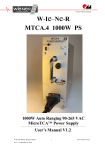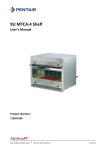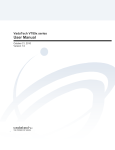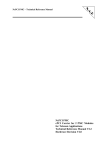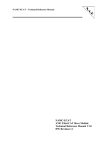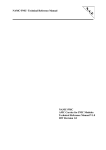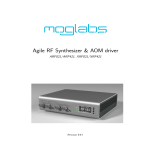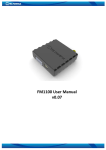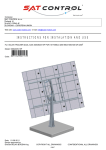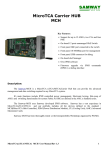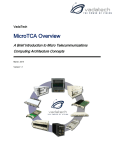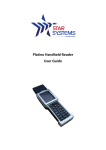Download W-Ie–Ne-R MTCA.4 1000W PS - W-IE-NE
Transcript
W-Ie–Ne-R MTCA.4 1000W PS 1000W Auto Ranging 90-265 VAC MicroTCA™ Power Supply User’s Manual V1.0 W-IE-NE-R Plein & Baus GmbH Rev. 1.0, March 20, 2014 1 www.wiener-d.com General Remarks The only purpose of this manual is a description of the product. It must not be interpreted as a declaration of conformity for this product including the product and software. W-Ie-Ne-R revises this product and manual without notice. Differences between the description in manual and the product are possible. W-Ie-Ne-R excludes completely any liability for loss of profits, loss of business, loss of use or data, interrupt of business, or for indirect, special incidental, or consequential damages of any kind, even if W-Ie-Ne-R has been advises of the possibility of such damages arising from any defect or error in this manual or product. Any use of the product which may influence health of human beings requires the express written permission of W-Ie-Ne-R. Products mentioned in this manual are mentioned for identification purposes only. Product names appearing in this manual may or may not be registered trademarks or copyrights of their respective companies. No part of this product, including the product and the software may be reproduced, transmitted, transcribed, stored in a retrieval system, or translated into any language in any form by any means without the express written permission of W-Ie-Ne-R. W-IE-NE-R Plein & Baus GmbH 2 www.wiener-d.com Table of contents: 1 GENERAL DESCRIPTION .................................................................. 4 1.1 MAIN FEATURES .............................................................................. 4 1.2 TECHNICAL SPECIFICATION....................................................... 5 2 2.1 FUNCTIONAL DESCRIPTION ........................................................... 6 DIGITAL POWER CONTROLLER................................................. 6 3 UTILIZATION........................................................................................ 7 4 FIRMWARE ............................................................................................ 9 5 USB™ LABVIEW™ SOFTWARE..................................................... 10 5.1 NATIONAL INSTRUMENTS SOFTWARE.................................. 10 5.2 USB™ CONNECTION ..................................................................... 10 5.3 LABVIEW™ PROGRAM: MTCA.4............................................... 12 W-IE-NE-R Plein & Baus GmbH 3 www.wiener-d.com 1 General Description The W-Ie-Ne-R MTCA.4 is a low noise and ripple high power density power supply in a double height / double width form factor designed according to the PICMG MTCA-4 standard. It provides continuously up to 1000W for 12V payload power as well as 3.3V management power. The W-Ie-Ne-R MTCA.4 includes the AC mains filter, the low noise AC-to-DC converter in switching technology as well as the digital power controller for up to 16 slots. Being designed with applying the classical rules for common mode suppression and ground loop reduction the W-Ie-Ne-R MTCA.4 power supply is essential for enhanced DAQ performance in noise sensitive applications in science and industry. In science these are all applications dealing with analogue sampling and generation above ten bits of resolution down to sub mV volts range. In industry those were applications with advanced requirements on analogue signal sampling quality ranging from speech, music, sonar up to video and radar signal generation/acquisition and processing. Hence the achievable resolution in the crate is mainly limited by the quality of tertiary noise sources like crate blowers or other DC/DC-converters onboard AMC cards. The integrated MTCA.4 Digital Power Controller together with the Hub protects the whole MTCA.4 crate and its modules. It also monitors the complete chain from mains input, PFC and DC/DC-converter stages to the outputs to prevent the unit from any uncontrolled operation. An internal MTCA.4 Digital Power Controller works in conjunction with a carrier hub acc. to the MTCA.1 and IPMI specifications. For reasons of final IPMI system software quality test and time to market for the IPMI software functionality W-Ie-Ne-R is in contract with N.A.T. – EUROPE. Additionally functioning of the power supply can be monitored via a LabVIEW™-program coupling to an external USB-Link without interrogation of processes controlled by the hub/s. This is default and is called “IPMI MTCA.4” mode. Supplementary the MTCA.4 Digital Power Controller can be driven also completely independent from a hub via the same USB-Link by switching into the so called “W-Ie-Ne-R Mode” within the same LabVIEW™-program. Here any AMC-Card can be switched on or off independently by buttons for each channel by hand (workshop/factory mode). 1.1 Main Features • 1000W continuous wattage, low noise power supply according to MTCA.1 specification • Discrete Converter Design in double height - double width MTCA size • Wide range auto ranging AC input 90 - 265 VAC / 50 - 60 Hz • Lowest noise and ripple, < 5 mV peak to peak (0 - 20 MHz) • Digital Power Controller for full IPMI compliance to MTCA.4 style carrier Hubs • 16 channels 12V DC, up to 8.4A each (Payload Power), 1000W in total • 16 channels 3.3V DC, up to 0.2A (Management Power) • Managed via MTCA.4 hub high level IPMI protocol stack (NatView™ compatible) • LabVIEW™ monitoring software with workshop mode via front panel USB W-IE-NE-R Plein & Baus GmbH 4 www.wiener-d.com 1.2 Technical Specification 1000W MTCA.4 Power Supply Input voltage, 47-63 Hz Output Ripple and Noise: Full load / 80% rated output (0-20 MHz Bandwidth) Regulation static: Change of output voltage versus load change 10100% Regulation static: Change of output voltage versus line change +/10% Regulation dynamic: Change of output voltage versus load change +/-25% per channel Recovery time versus load change 10-100% Recovery time versus load change +/-25% Output impedance: Static / Dynamic(at 100 kHz, 6V output) Temperature Error Thermal Protection (No. of thermal switches) Derating, max. operating temperature 12V Payload Power 90V-265V, <16A sinusoidal < 4 mVpp / < 2 mVrms < 0,1% or < 15 mV < 0,02% or 4 mV < 0,02% or 4 mV < 0,2 ms for < 1% deviation 0,5 mΩ / 250 mΩ < 0,02 %/K (5x) No derating up to 50°C 3V3 Management Power Output Ripple and Noise: Full load / 80% rated output (0-20 MHz Bandwidth) Line Regulation Accuracy Load Regulation Accuracy Output Ripple Frequency Recovery time versus load change 0-100% Recovery time versus load change +/-50% Short Time / Long Time Output Current Limit EMC compatibility EN 61 000-6-3:2001 EN 55 022:1998 + Corr:2001 + A1:2000 Class B EN 55 022:1998 + Corr:2001 + A1:2000 Class B EN 61 000-3-2:2001 EN 61 000-3-3:1995 +Corr:1997 +A1:2001 EN 61 000-6-2:2001 EN 61 000-4-6:1996 + A1:2001 EN 61 000-4-3:1996 + A1:1998 + A2:2001 EN 61 000-4-4:1995 + A1:2001 EN 61 000-4-5:1995 + A1:2001 EN 61 000-4-11:1994 + A1:2000 EN 61 000-4-2:1995 + A1:1998 + A2:2001 W-IE-NE-R Plein & Baus GmbH 5 < 5 mVpp / < 3 mVrms <0,2% <0,6% 1.25 MHz < 0,01 ms for < 25 mV deviation 8A / 4A RF emission conducted noise radiated noise harmonics flicker immunity injected HF currents radiated HF fields, ”900 MHz” burst surge voltage variations ESD www.wiener-d.com 2 Functional Description First stage of the MTCA.4 Power Supply is a chambered high performance two-stage AC-mains input filter blocking all differential and common mode EMI from the inside to levels beyond the EN 55 022 - CLASS B. The second stage is a high efficient intelligent PFC with low noise and ripple. The capacitor banks store enough energy to prevent the crate for minor mains power drops. In a third stage a high efficient DC/DC-Full-Bridge Converter is working in Zero Voltage Switching Technology. Fourth a DC-Output capacitor bank with sophisticated output filter circuitry is standard for all MTCA.4 Power Supplies. As last comes the Digital Power Controller. By definition of the MTCA.1 specification the intelligent counterpart for the Carrier Manager Hub MCH talking to is the Digital Power Controller as part of the W-Ie-Ne-R MTCA.4 power supply. All channels and outputs can be configured with the MCH Hub Software via the IPMI protocol with exception on the MCH and CU (Cooling Units) channels themselves which are configured during startup after autonomous operation. 2.1 Digital Power Controller The Digital Power Controller together with the Hub protects the whole MTCA.4 crate and its modules. It also monitors all parameters like voltages, currents and temperatures for the complete chain from the mains input over the PFC and DC/DC-converter stage to the outputs. 12 V Outputs (Payload Power) Input Voltage Setpoint 12.6 Vdc typical 11.8 Vdc typical as Primary PM as Redundant PM Management Power Interdependence 12 V will not be applied without 3.3 V applied to a load Removal of 3.3 V also removes 12 V and de-asserts ENABLE# Maximum Load up to 8,4 A maximum per channel Load Count 16 Channels ON/OFF per ENABLE#[1..16] per MTCA.4 MCH Controller Complete ORING device with PASS & BLOCK FETS Over Current Protection 2,1 .. 8.4A / 0.41 .. 12.71 ms Shutdown individually programmable per MCH Controller Current limit voltage: 4 Bit Time out times: 5 Bit Short Circuit / Inrush Protection 5,0 .. 20,0 A 4 Bit programmable fast trip current (proportional to OCP) Low Voltage Protection 10,2V .. 12,0V in steps of 600 mV Power Good Condition: 2 Bit Longtime/Failure Supervision Monitor 12 Bit Sampling of individual channel Current/Voltage/Power Running Means of up to 128 Samples for Module Supervision and Data Logging W-IE-NE-R Plein & Baus GmbH 6 www.wiener-d.com 3.3 V Outputs (Management Power) Input Voltage Setpoint 3.3 Vdc typical Total Regulation Range 3.16 to 3.63 Vdc Extracted from 12 V Input Voltage Rated Load 1.6A / 6W per Power Adapter 200 mA / 0.7W per Module (clamped by channel controller) SMP (Shared Management Power) Output Voltage 3 4.5 .. 5.5 Vdc typical 2..3 A max (recovering fuse: 1A) Internally Short Circuit/Overload/Overvoltage protected (a short on SMP shuts down the whole crate) Utilization The W-Ie-Ne-R MTCA.4 is intended for stationary use in MTCA.1 or MTCA.4 crates under normal operating conditions. For more rugged or other implementations please contact the factory. Internal fusing is a slow-blow fuse of 16A for pure input protection of the power supply. This fuse is not thought to and does not replace any external circuit breaker/s. W-Ie-Ne-R recommends to fuse each unit externally with an individual and faster circuit breaker adjusted to the mains conditions of the corresponding country (e.g. Germany: 5A-6A, Class B, C, old K, H). Hot Swap Switch Fault / LED1 PFC LED Mini USB Plug Blue / Status LED Figure 1: The W-IE-NE-R MTCA.4 Power Supply Front Panel Elements W-IE-NE-R Plein & Baus GmbH 7 www.wiener-d.com The MTCA Crate starts automatically after powering of the W-Ie-Ne-R MTCA.4 power supply. Shortly after the W-Ie-Ne-R MTCA.4 power supply is at mains the PFC needs some seconds to fill the capacitor banks while the green PFC LED shows short fast blink, see fig 1. When fully operational the PFC LED shows steady green state. If the PFC has any major problem it will show it with special blinking codes (e.g. long-short-short) important for W-Ie-Ne-R repair workshop. As specified in the PICMG MTCA.1 specification the crate starts first in autonomous mode with both blowers (CUs, cooling units) on at maximum speed and the management hubs (MCHs) on. After established communication with the power supply module (PM) the individual powers for the attached AMC cards are distributed. If the calculated power budget is finished no further AMC card will be integrated into the system. Finally the blowers speed down and up to a final optimum. State-of-the-art to switch MTCA.4 crates ON and OFF regularly is to invoke it via one of the MCHs command interfaces. Drawback is that the crate is not really OFF then: While all AMC cards power down the CUs still work but at a minimum rate to cool the PM/s and the MCH/s. This may be acceptable for a counting room but will not be silent enough for a laboratory. Else if one likes to switch OFF the supply by hand W-Ie-Ne-R recommends to push the ◙ / HSS (Hot Swap Switch) only once, see fig. 1. Then the W-Ie-Ne-R MTCA.4 will request the MTCA hub to power down the crate completely controlled. After this interrogation the Blue Status LED on the power supply front panel is starting blinking signaling that this action has been finished. After this the W-Ie-Ne-R MTCA.4 power supply is in the Hot Swap Status. The crate is then completely silent. While in Hot Swap Status return the crate back into operation by one push on the ◙ / HSS switch – or – unplug the power cord or use an external circuit breaker to finally switch off the crate – or – extract the module from one crate to another (with power cord on) – or – move it to another power slot position (with power cord on). W-Ie-Ne-R recommends not too often or regularly switch OFF the crates power supply by – or – unplugging the power or power cord when just on substantial load, – or – tearing the power supply out of the slot when just on substantial load, even though the supply itself would not directly fear damage by doing this. If more than one W-Ie-Ne-R MTCA.4 power supply resides in a crate switching on/off is more complex if special redundancy conditions have to be met (1+1, or 2+0). All states following the autonomous operation are controlled by the management work of an MCH. The MCH supported redundancy setups will depend on the last or actual backplanes EEPROM configuration (FRU settings) as well as on the geographical addresses under which the power supplies reside. For state-of-the-art power redundancy and power sharing modes please refer to the MTCA.1 specification standard or request help from your system partner (e.g. N.A.T./ELMA/VadaTech). For big detector or accelerator systems with many crates it is recommended to systematically install a bank of “smart” circuit breakers for all power supplies so that longer shutdown phases can be effectively realized – means power off/on of crates can be steered remotely in a sequential way. Optimally the individual PM Hot Swap States can be invoked via remote calls before a power off. FLT is signaling for any reason of repair or maintenance or during firmware upgrade, see fig. 1. W-IE-NE-R Plein & Baus GmbH 8 www.wiener-d.com 4 Firmware At the time of writing, a standard IPMI Firmware Refresh is only supported via the NatView™ software, http://www.nateurope.com/, which has to be registered to the user by N.A.T. In NatView™ the update/upgrade process is called “HPM Update” and can be invoked by first selecting of the corresponding W-Ie-Ne-R MTCA.4 power supply, called “PM-AC 1000” in the resource list. Then one can infer HPM-Update via the pull down menu or the special icon (tooltip): In the opening window direct to a link to the corresponding “.hpm” firmware file to be found and downloaded via the W-Ie-Ne-R web file archive under: http://file.wiener-d.com/firmware/. When invoked the download via IPMI (I2C-Interface) will take a longer time until accomplished (about ten minutes). During download FLT/LED1 is signaling that the download process should not be disturbed. When accomplished the PM has to be rebooted for the new version. A possibly faster/easier/free way of firmware refresh via the front panel USB interface depends on the generation of a new download program tool (boot loader) and will be made accessible through the W-Ie-Ne-R file archive to all users as soon as it is available. W-IE-NE-R Plein & Baus GmbH 9 www.wiener-d.com 5 USB™ LabVIEW™ Software Using the LabVIEW™ monitoring or workshop software is another way to get view or access to some intrinsics of the W-Ie-Ne-R MTCA.4 Power Supply Controller. 5.1 National Instruments Software Basically you need the LabVIEW Run-Time Engine 2012 residing on your computer. If not please refer to the corresponding home pages from National Instruments (www.ni.com, the path be e.g. Home Page > Support > Downloads > Drivers > NI Hardware Drivers). Additionally you need to have installed the NI-VISA Virtual Instrument Software Architecture which is a proprietary standard for handling of computer interfaces like USB, GPIB, RS232 with (not only) LabVIEW. Normally it still resides on your computer if you installed a LabVIEW (of any version) or another NI Development Software. If not you can find the corresponding software for free download under (www.ni.com, e.g. www.ni.com/download/ni-visa-5.4/4230/en/ and start “visa540_full.exe” actually for Windows). Finally you should find the NI Measurement and Automation Explorer in the VISA subfolder of the National Instruments Program Folder or just have a NI-MAX icon on the desktop. 5.2 USB™ Connection To take advantage of the MTCA.4 software (Auxiliary Diagnostic Supervisor) first of all you have to connect your PC via an Standard USB to the MTCA.4 Mini USB AB connector on the left top side of the front panel (Fig.1). Invoke the “Other Devices” in the Device Manager (Start > Control Panel > System > Device Manager): W-IE-NE-R Plein & Baus GmbH 10 www.wiener-d.com If the USB connection has been found there must be some “MTCA.4 Power Supply” statement under “COM and LPT connections”, with or probably without an exclamation mark. If it has exclamation mark the corresponding driver is just not in your portfolio of W-Ie-Ne-R registered USB drivers. For this select a new driver or actualize it via the pull down menu activated by clicking the right mouse button on the MTCA.4 Power Supply statement. Select the new driver by the professional way by doing it not automatically but by hand and clicking through the statements such as to select the file folder container yourself. Select the folder in which you have copied or unzipped the files, e.g. „E:\vcpDriver“ and confirm all the installation messages. You will get the windows signed driver files in the W-Ie-Ne-R web file archive under http://file.wiener-d.com/software/vcpDriver. Finally confirm the installation success message. Then the exclamation mark in the folder “Other Devices“ at the MTCA.4 Power Supply device should vanish and the corresponding COM Port Number should follow the name in brackets. In NI-MAX this connection will then appear too: W-IE-NE-R Plein & Baus GmbH 11 www.wiener-d.com 5.3 LabVIEW™ Program: MTCA.4 This software is availlable in the W-Ie-Ne-R file server archive (http://file.wiener-d.com/ software/MTCA.4). The MTCA.4 program is simply consisting of following three files: Starting the executable leads to one single LabVIEW Front Panel from which everything can be monitored, see fig. 1. You can stop the program easily via the button at the lower left corner or simply close the window itself at the upper right. To have always an eye on the USB connection the USB settings block always resides at the lower left to show if the selectable COM-port is established and running. If yes the transfers counter is counting while the USB running LED is at green. Tooltips everywhere in the program direct to short help messages: The software starts in the last but one of two modes the MTCA.4 can be working. By factory setup the default Mode is the MTCA.4 IPMI mode. This should be changed only if the crate is to be run without an MCH carrier hub or for more than diagnostic monitoring purposes. Figure 1: The MTCA.4 Monitoring Software in normal/default MTCA.4 Mode W-IE-NE-R Plein & Baus GmbH 12 www.wiener-d.com Sometimes if allocation of severe system problems is needed the or a MTCA crate may simply run without a hub for tests the W-Ie-Ne-R Mode can be activated by simply plugging the Run Mode Button within the USB Settings Block. The internal system reboots which needs some time and the USB run LED gets green after some seconds. Sometimes it does restart then in the original mode - then please retry once more. Please be aware that the implemented mode resides permanent even after a power down of mains. A switch back is possible only with this software and can not be invoked via a MCH system call. In W-Ie-Ne-R mode the front panel is the same but presented with much more detail, see. Fig. 2. Figure 2: The MTCA.4 Monitoring Software in W-IE-NE-R Mode At start-up all 12 AMC Card Channels and the 2 MCH and 2 CU channels are all starting with the maximum current settings of 8.4 Amps. Again tooltips show for additional hints. If not a problem for the attached hardware in the crate feel free to play around with the channels parameters. It is possible e.g. to switch on and off every channel individually whether Payload or Management Power at any time or change the current limits in a fine grain. W-IE-NE-R Plein & Baus GmbH 13 www.wiener-d.com













